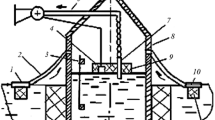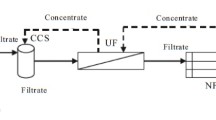Abstract
The article describes the research and subsequent application of the electric coagulating agents and galvanic coagulating agents. These may be used in order to raise the standard of the treatment of wastewater containing oil substances. A method of desalination of natural waters and wastewater by means of a dialyzer with a multilayer liquid membrane was designed. Our research obtained by the new way of filtration of oil substances and suspended substances has been designed for an ultra-gentle treatment of water. In comparison with already familiar methods like ultra-filtration and reverse osmosis, this new way has certain advantages. The function of materials will be examined in this article. Based on the research, we have found that the main advantages of the method using the coagulating agent are treatment efficiency, simple installation, etc. Agents can be used to increase the level of treatment of wastewater containing crude oil substances. We found and have demonstrated that, compared to usual methods used in the industry, e.g. heating (evaporation), ion exchange and other methods of demineralization (desalination) of wastewater, the presented way has several advantages like decreasing energy losses.





Similar content being viewed by others
References
Achmedžanov TK, Achtanov EK, Nubajeva BM (2011) Ways of improvement of pipelines//materials from the International scientific-technical conference. In: Oil and gas in the West Siberia dedicated to the 55. Anniversary of the Tyumen State Oil and Gas University, Tyumen, p 244
Borges ME, Hernández T, Esparza P (2014) Photocatalysis as a potential tertiary treatment of urban wastewater: new photocatalytic materials. Clean Technol Environ Policy 16:431
Commission Directive 2000/60/EC of 23 October 2000 of the European Parliament and of the Council, framework for Community action in the field of water policy
Commission Directive 2009/90/EC of 31 July 2009 laying down, pursuant to Directive 2000/60/EC of the European Parliament and of the Council, technical specifications for chemical analysis and monitoring of water status
Crispim A, Sampaio A, Ramalho E, Ramos L, Caetano NS, Silva PC, Fernandes R (2010) Biodiesel from fleshings. J Soc Leather Technol Chem 94:39
Doraisamy P, Nandakumar NB, Maheswari M, Selvamurugan M (2013) Comparative performance of anaerobic reactors for treatment of sago industry wastewater. Clean Technol Environ Policy 15:391
Fathima NN, Aravindhan R, Rao JR, Nair BU (2011) Stabilized protein waste as a source for removal of color from wastewaters. J Appl Polym Sci 120:1397
Gaidau C, Niculescu M, Stepan E, Taloi D, Filipescu L (2009) Additives and advanced biomaterials obtained from leather industry by-products. Rev Chim 60:501
Kalyanaraman C, Sri Bala Kameswari K, Sudharsan Varma V, Tagra S, Raghava Rao J (2013) Studies on biodegradation of vegetable-based fat liquor-containing wastewater from tanneries. Clean Technol Environ Policy 15:633
Kamenščikov FA, Bogomoľskij EI (2006) Removal of crude oil substances from the surface of water and ground. Moscow, p 521
Kameswari KSB, Kalyanaraman C, Thanasekaran K (2014) Evaluation of various pre-treatment processes on tannery sludge for enhancement of soluble chemical oxygen demand. Clean Technol Environ Policy 16:369
Kanimozhi R, Vasudevan N (2014) Effect of organic loading rate on the performance of aerobic SBR treating anaerobically digested distillery wastewater. Clean Technol Environ Policy 16:467
Maximov EA Electric separator, RU 137475 U1
Maximov EA Electrodialyzer with a multilayer liquid membrane (positive solution No. 2012139933/05)
Maximov EA Mechanism for filtration of suspension solutions (positive solution No. 2013131606)
Maximov, E.A. Ways and mechanism of industrial wastewater treatment (positive solution No. 20131203541/05
Maximov EA Ways of purification of natural waters and wastewater (positive solution No 20121099957/05)
Mukherjee R, Sengupta D, Sikdar SK (2013) Parsimonious use of indicators for evaluating sustainability systems with multivariate statistical analyses. Clean Technol Environ Policy 15:699
Pintor AMA, Vilar VJP, Botelho CMS, Boaventura RAR (2014) Optimization of a primary gravity separation treatment for vegetable oil refinery wastewaters. Clean Technol Environ Policy 16:1725
Quevauviller P, Thomas O, Beken AV (2006) Wastewater quality monitoring and treatment., Water quality measurements seriesWiley, Hoboken 7
Sekaran G, Karthikeyan S, Evvie C, Boopathy R, Maharaja P (2013) Oxidation of refractory organics by heterogeneous fenton to reduce organic load in tannery wastewater. Clean Technol Environ Policy 15:245
Shaffei KA, Moustafa AB, Mohamed WS (2008) Grafting emulsion polymerization of glycidyl methacrylate onto leather by chemical initiation systems. J Appl Polym Sci 109:3923
Sikdar SK (2012) Measuring sustainability. Clean Technol Environ Policy 14:153
Sikdar SK (2013) Resurgence of fossil fuels? Clean Technol Environ Policy 15:203
Sikdar SK, Sengupta D, Harten P (2012) More on aggregating multiple indicators into a single index for sustainability analyses. Clean Technol Environ Policy 14:765
Song J, Tao WY, Chen WY (2008) Ultrasound-accelerated enzymatic hydrolysis of solid leather waste. J Clean Prod 16:591
Stachov EA (1983) Purification of wastewater containing oil substances; protection and transport of oil substances. Leningrad, p 234
Staff A (2011) Reverse osmosis and nanofiltration. American Water Works Association, Denver, p 226
Staršich VV, Maximov EA Positive solution No. 2013125187/03
Vasiljev VI, Dolotov AI, Kazilov PV, Cipačeva MA Filtrating material, SU 1421373 A1
Vasiljev VI, Kazilov PV, Vološčuk EA Filtrating material for industrial wastewater treatment, RU 2311220 C1
Voutchkov N (2011) Desalination plant concentrate management. Water Treatment Academy Publications, Bangkok, p 48
Wang XC, Ren LF, Qiang TT (2009) Novel way of transformation of tannery waste to environmentally friendly formaldehyde scavenger. Environ Prog Sustain Energy 28:285
Zeman LJ, Zydney AL (1996) Microfiltration and ultrafiltration: principles and applications. CRC Press, Boca Raton, p 642
Acknowledgments

Author information
Authors and Affiliations
Corresponding author
Rights and permissions
About this article
Cite this article
Maksimov, E.A., Kreheľ, R. & Pollák, M. Prospective systems and technologies for the treatment of wastewater containing oil substances. Clean Techn Environ Policy 18, 161–170 (2016). https://doi.org/10.1007/s10098-015-1003-0
Received:
Accepted:
Published:
Issue Date:
DOI: https://doi.org/10.1007/s10098-015-1003-0




